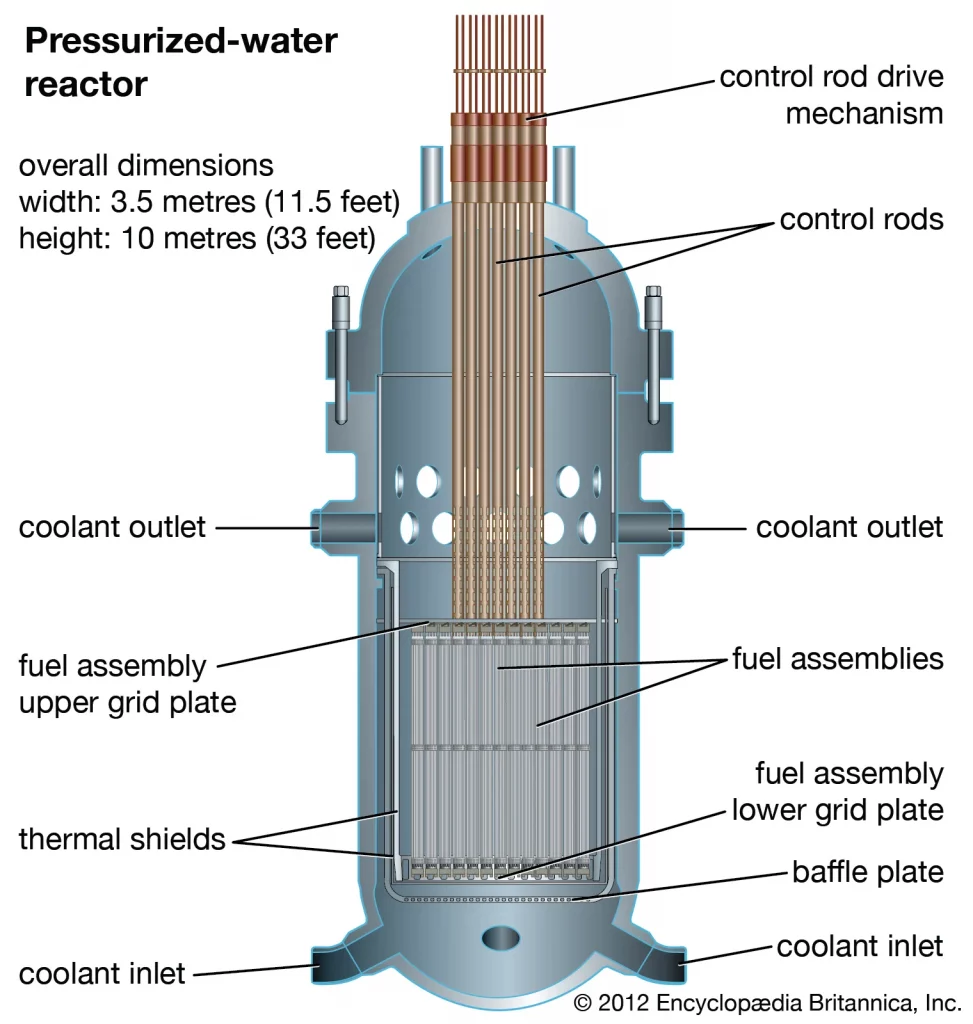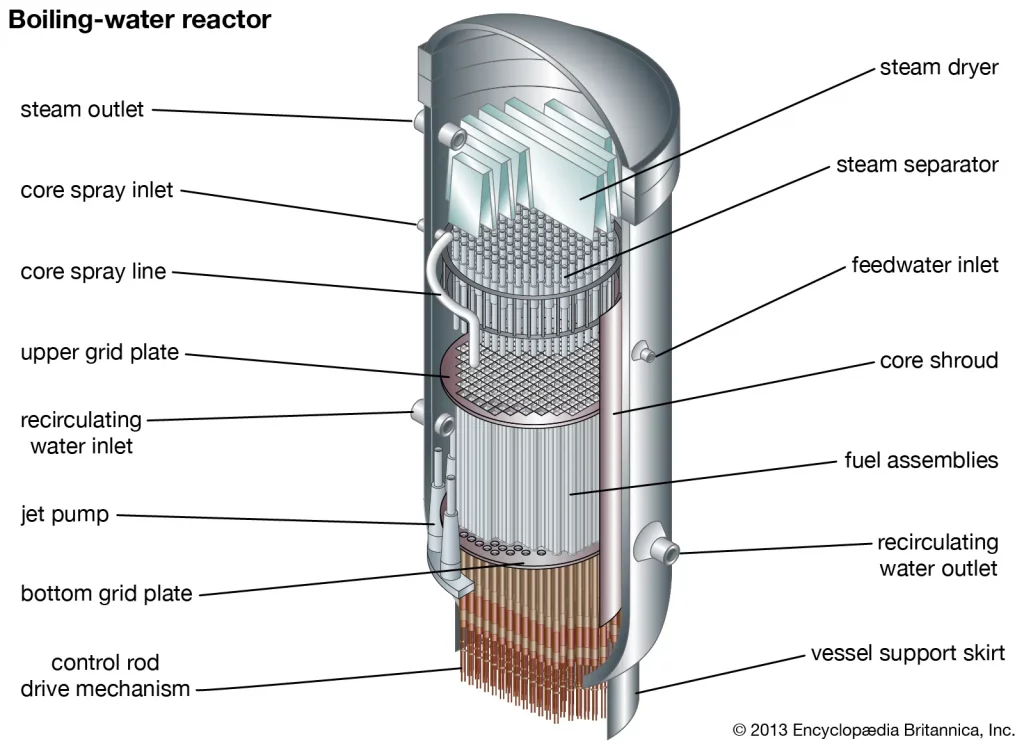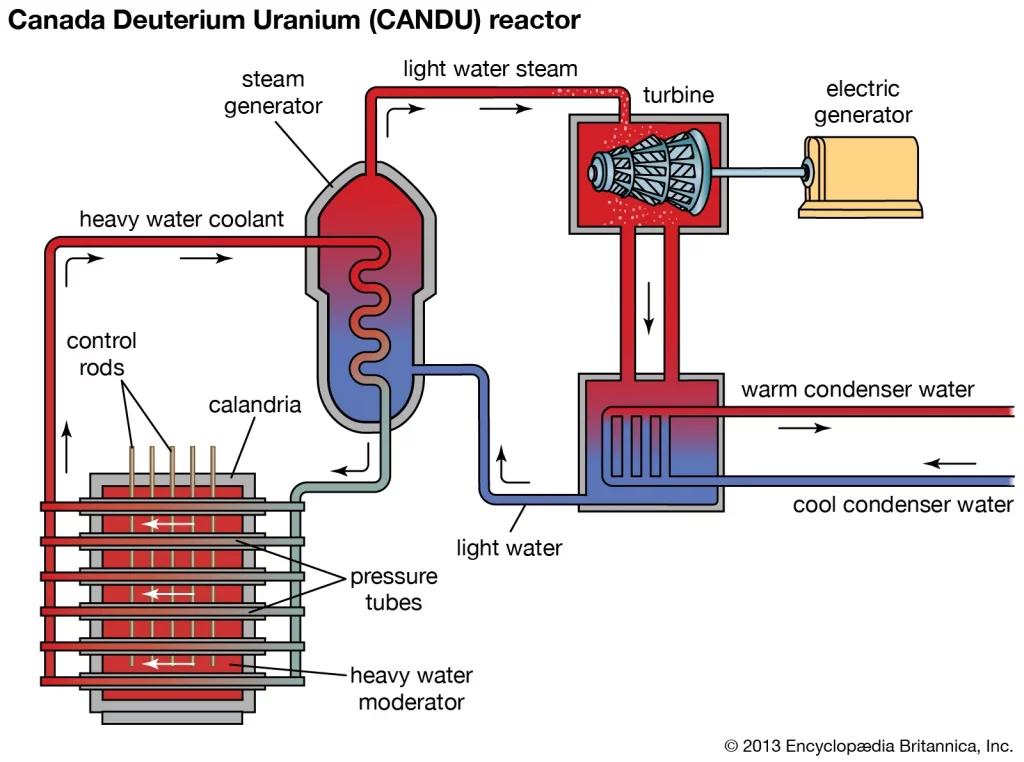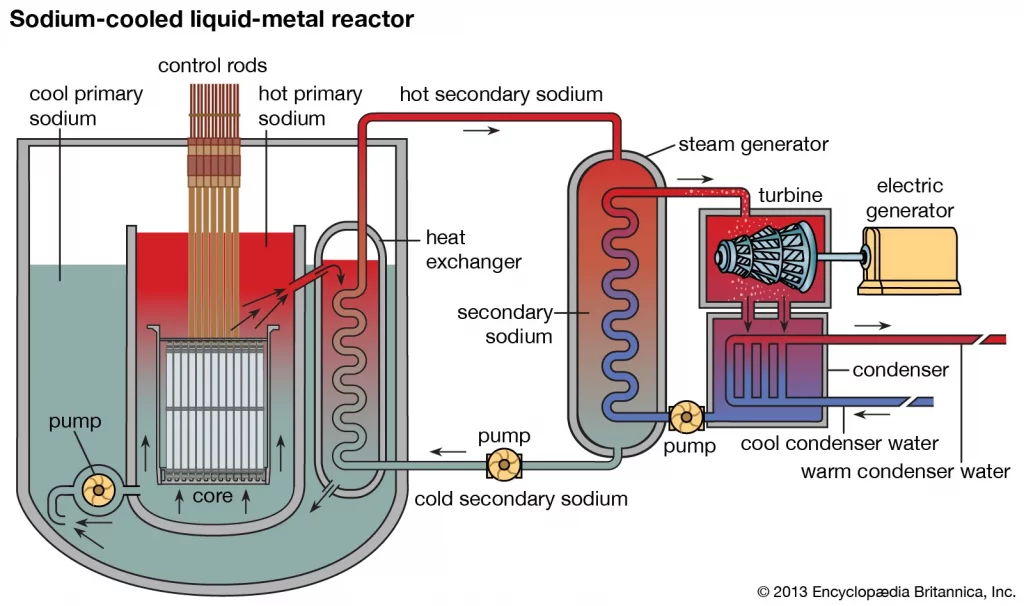Nuclear reactors are machines that contain and control nuclear chain reactions while releasing heat at a controlled rate.
A nuclear power plant uses the heat that a nuclear reactor produces to turn water into steam, which then drives turbine generators that generate electricity.
There are several types of power reactors, but only one, the light-water reactor, is widely used.
Light-water reactors
Light-water reactors (LWRs) are power reactors that are cooled and moderated with ordinary water. There are two basic types: the pressurized-water reactor (PWR) and the boiling-water reactor (BWR).
Pressurized-water reactor (PWR)
In the PWR, water at high pressure and temperature removes heat from the core and is transported to a steam generator. There the heat from the primary loop is transferred to a lower-pressure secondary loop also containing water. The water in the secondary loop enters the steam generator at a pressure and temperature slightly below that required to initiate boiling. Upon absorbing heat from the primary loop, however, it becomes saturated and ultimately slightly superheated. The steam thus generated ultimately serves as the working fluid in a steam-turbine cycle.
- Pros:
- Strong negative void coefficient — reactor cools down if water starts bubbling because the coolant is the moderator, which is required to sustain the chain reaction
- Secondary loop keeps radioactive stuff away from turbines, making maintenance easy.
- Very much operating experience has been accumulated and the designs and procedures have been largely optimized.
- Cons:
- Pressurized coolant escapes rapidly if a pipe breaks, necessitating lots of back-up cooling systems.
- Can’t breed new fuel — susceptible to “uranium shortage”

Boiling-water reactor (BWR)
A BWR operates on the principle of a direct power cycle. Water passing through the core is allowed to boil at an intermediate pressure level. The saturated steam that exits the core region is transported through a series of separators and dryers located within the reactor vessel that promote a superheated state. The superheated water vapour is then used as the working fluid to turn the steam turbine.
- Pros:
- Simpler plumbing reduces costs
- Power levels can be increased simply by speeding up the jet pumps, giving less boiled water and more moderation. Thus, load-following is simple and easy.
- Very much operating experience has been accumulated and the designs and procedures have been largely optimized.
- Cons:
- With liquid and gaseous water in the system, many weird transients are possible, making safety analysis difficult
- Primary coolant is in direct contact with turbines, so if a fuel rod had a leak, radioactive material could be placed on the turbine. This complicates maintenance as the staff must be dressed for radioactive environments.
- Can’t breed new fuel — susceptible to “uranium shortage”
- Does not typically perform well in station blackout events, as in Fukushima.

CANDU Reactors [ Canada Deuterium Uranium (CANDU) reactor ]
The CANDU is a Canadian pressurized heavy-water reactor design used to generate electric power. The acronym refers to its deuterium oxide moderator and its use of uranium fuel.
It uses enriched Uranium as its fuel while Heavy water serves as coolant and neutron moderator. The heavy water is kept under high pressure, allowing it to be heated to higher temperatures without boiling, like in pressurized water reactor
- Pros:
- Requires very little uranium enrichment.
- Can be refueled while operating, keeping capacity factors high (as long as the fuel handling machines don’t break).
- Are very flexible, and can use any type of fuel.
- Cons:
- Some variants have positive coolant temperature coefficients, leading to safety concerns.
- Neutron absorption in deuterium leads to tritium production, which is radioactive and often leaks in small quantities.
- Can theoretically be modified to produce weapons-grade plutonium slightly faster than conventional reactors could be.

Sodium Cooled Fast Reactor
A sodium-cooled fast reactor is a fast neutron reactor cooled by liquid sodium. The initials SFR in particular refer to two Generation IV reactor proposals, one based on existing liquid metal cooled reactor technology using mixed oxide fuel, and one based on the metal-fueled integral fast reactor.
These reactors are cooled by liquid sodium metal. Sodium is heavier than hydrogen, a fact that leads to the neutrons moving around at higher speeds (hence fast). These can use metal or oxide fuel, and burn a wide variety of fuels.
Several sodium-cooled fast reactors have been built and some are in operation, particularly in Russia.
- Pros:
- Can breed its own fuel, effectively eliminating any concerns about uranium shortages (see what is a fast reactor?)
- Can burn its own waste
- Metallic fuel and excellent thermal properties of sodium allow for passively safe operation — the reactor will shut itself down safely without any backup-systems working (or people around), only relying on physics.
- Cons:
- Sodium coolant is reactive with air and water. Thus, leaks in the pipes results in sodium fires. These can be engineered around but are a major setback for these reactors.
- To fully burn waste, these require reprocessing facilities which can also be used for nuclear proliferation.
- The excess neutrons used to give the reactor its resource-utilization capabilities could clandestinely be used to make plutonium for weapons.

Fast Reactors
A fast-neutron reactor (FNR) or fast-spectrum reactor or simply a fast reactor is a category of a nuclear reactor in which the fission chain reaction is sustained by fast neutrons (carrying energies above 1 MeV or greater, on average), as opposed to slow thermal neutrons used in thermal-neutron reactors.
Such a fast reactor needs no neutron moderator but requires fuel that is relatively rich in fissile material when compared to that required for a thermal-neutron reactor.
Fast reactors are a class of advanced nuclear reactors that have some key advantages over traditional reactors in safety, sustainability, and waste.
While traditional reactors contain moderators to slow down neutrons after they’re emitted, fast reactors keep their neutrons moving quickly (hence the name). Fast neutrons can unlock the energy in the dominant isotope of uranium (U238) and thus extend known fuel resources by around 200x.
Pros
- Fast reactors get more neutrons out of their primary fuel than thermal reactors, so many can be used to breed new fuel, vastly enhancing the sustainability of nuclear power.
- Fast reactors are capable of destroying the longest-lived nuclear waste, transforming it to waste that decays to harmlessness in centuries rather than hundreds of millennia.
- Fast reactors typically use liquid metal coolants rather than water. These have superior heat-transfer properties and allow natural circulation to remove the heat in even severe accident scenarios. The result: if something goes very wrong at the plant, and none of the operators are awake, AND none of the control rods work, the reactor can just naturally shut itself down. This comes with a con (see cons).
- Fast reactors can employ metallic fuel rather than oxides (thanks to chemical compatibility with the liquid metal coolant). Since metal has very high thermal conductivity, the reactor can shut itself down without surpassing temperature limits. This enhances the safety of these reactors significantly.
Cons
- While fast reactors are up to 200x more resource efficient, they require 3x or more fissile atoms to start up initially. This is the main reason why thermal reactors were developed first.
- Time scales in fast reactors are typically faster than those in thermal reactors (mostly because there are fewer delayed neutrons in fast reactors). Thus they can go through unpredicted changes faster than thermal reactors.
- Bubbles in fast reactor coolant can cause the reactor to heat up rather than cool down, as in a traditional reactor. Higher heat makes more bubbles, which make more heat, and so on. This positive feedback is scary (but manageable, thanks to overpowering negative feedback).
- To keep the neutrons moving quickly, fast reactors require exotic coolants derived from heavy atoms. The most common coolant is liquid sodium, which is well known but highly reactive with air and water. Another is liquid lead-bismuth eutectic, which isn’t the most pleasant material either. These bizarre materials require extra care and lower tolerance in many systems (such as piping), possibly bringing costs up.
